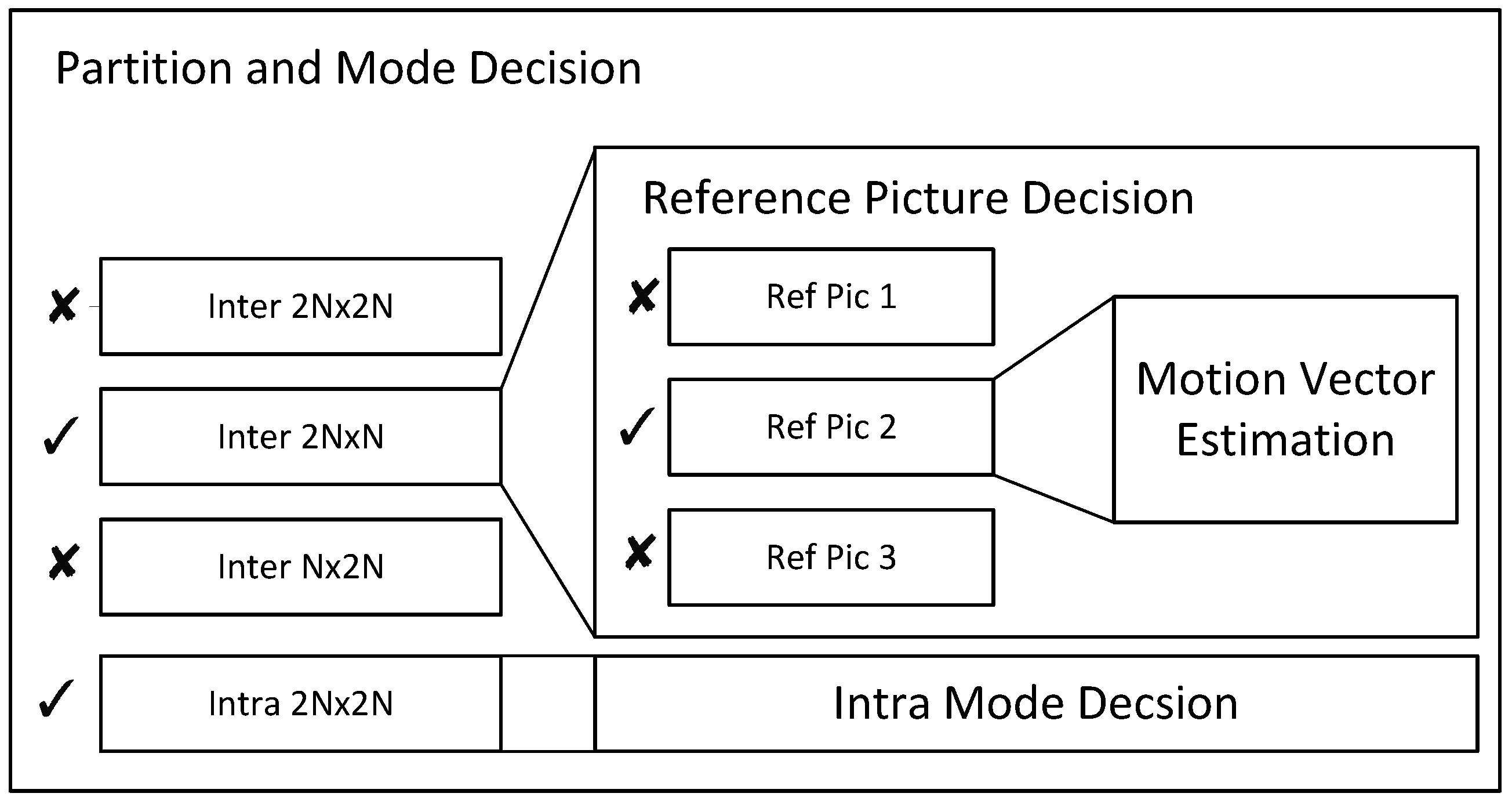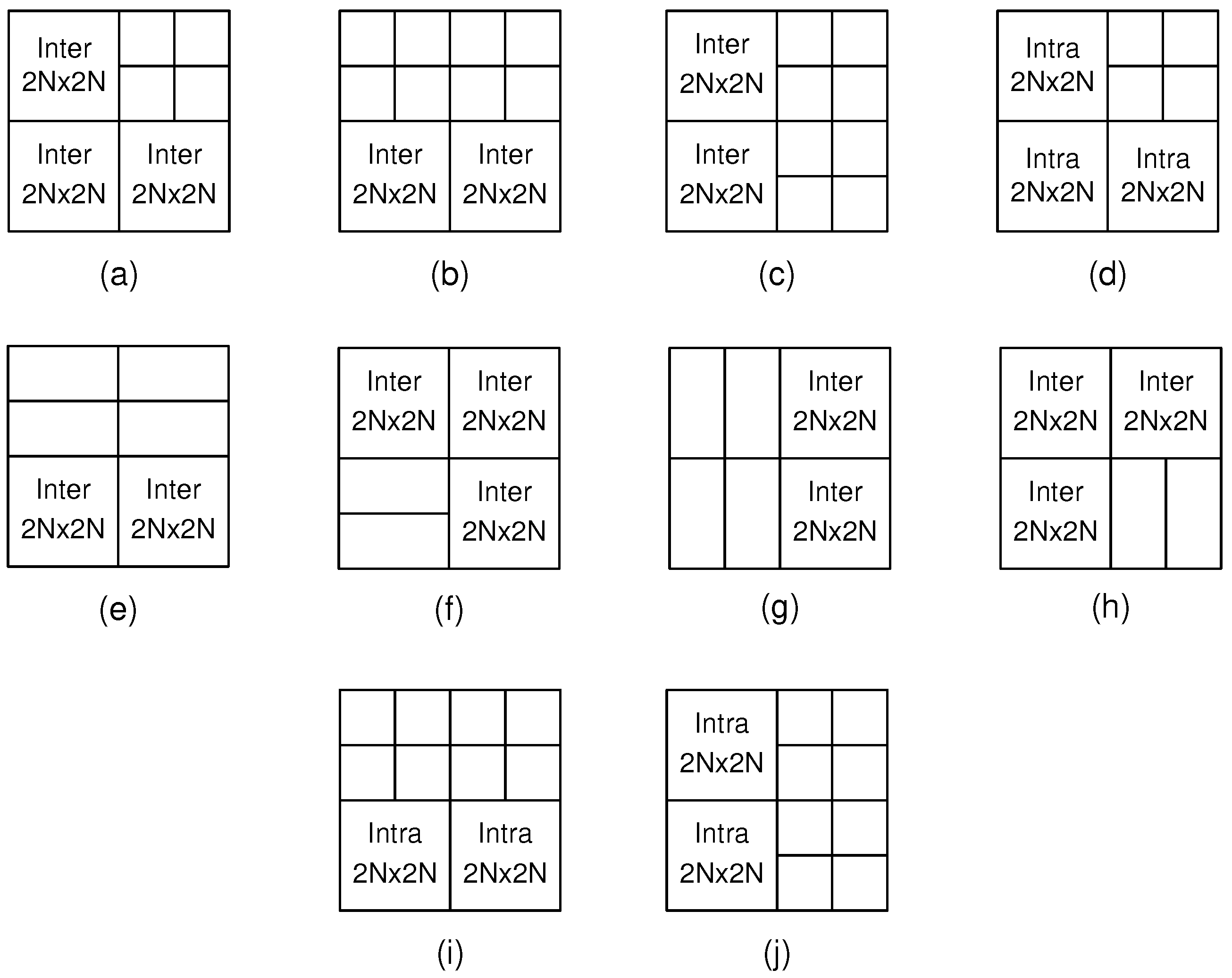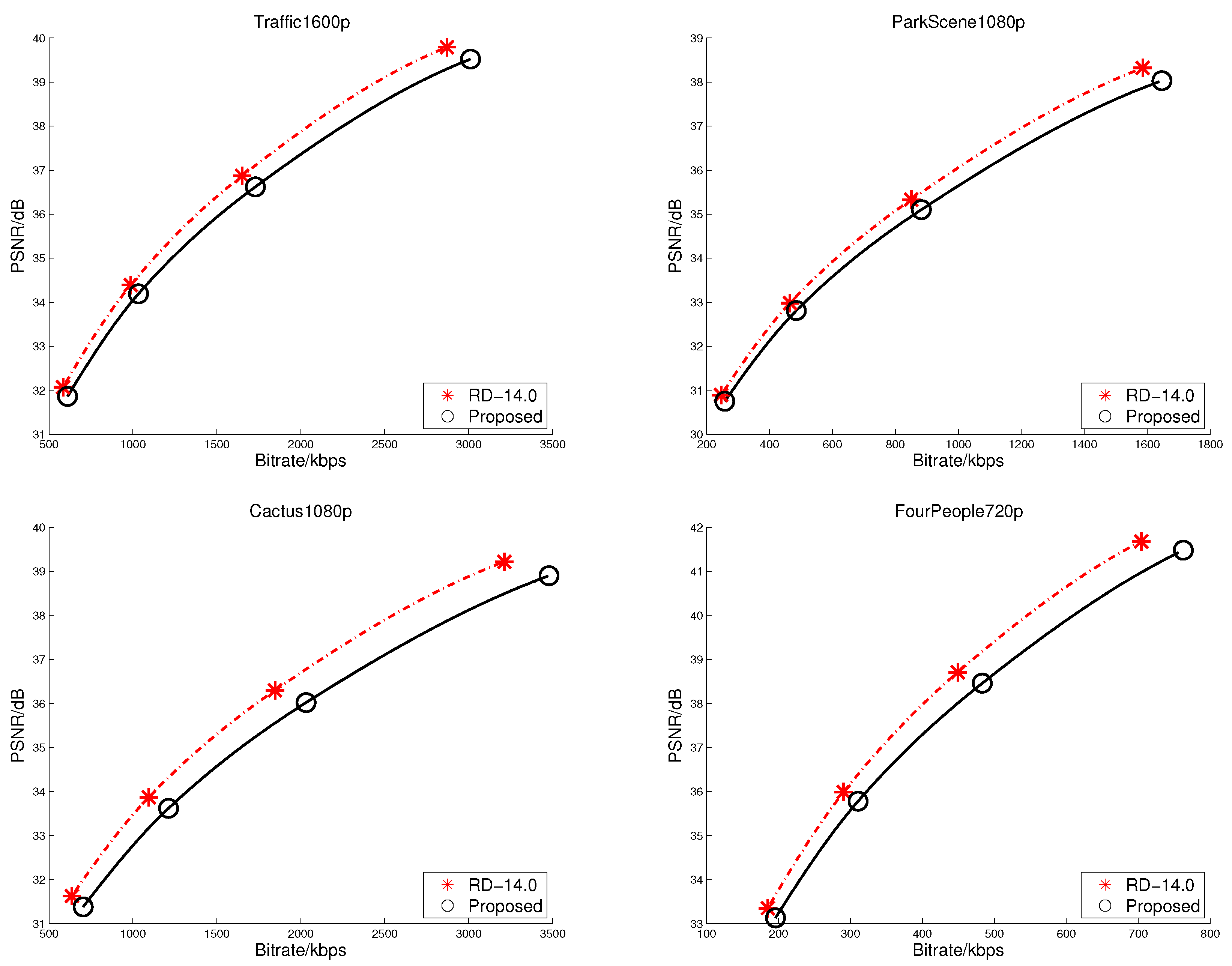Efficient Software HEVC to AVS2 Transcoding
Abstract
:1. Introduction
2. Related Work
3. Comparison between HEVC and AVS2 Standards
3.1. Partition Sizes
3.2. Intra Prediction
3.3. Inter Prediction
3.4. Other Coding Tools
4. The Proposed Algorithms
4.1. Fast Partition Mode Decision
- 1.
- Direct/Skip modes are always checked.
- 2.
- Inter 2N × 2N is checked when there exist more than two sub-CUs using Inter 2N × 2N (To simplify the discussions, the Merge 2N × 2N and SKIP modes in HEVC are treated as special cases of the Inter 2N × 2N mode).
- 3.
- Inter 2N × N is checked when both the two upper or both the two lower sub-CUs use Inter 2N × 2N.
- 4.
- Inter N × 2N is checked when both the two left or both the two right sub-CUs use Inter 2N × 2N.
- 5.
- Intra 2N × 2N is checked when there exist more than two sub-CUs using Intra 2N × 2N.
- 6.
- Inter 2N × nU is checked when the two lower sub-CUs use Inter 2N × 2N and more than one of the two upper sub-CUs use Inter 2N × N.
- 7.
- Inter 2N × nD is checked when the two upper sub-CUs use Inter 2N × 2N and more than one of the two lower sub-CUs use Inter 2N × N.
- 8.
- Inter nL × 2N is checked when the two right sub-CUs use Inter 2N × 2N and more than one of the two left sub-CUs use Inter N × 2N.
- 9.
- Inter nR × 2N is checked when the two left sub-CUs use Inter 2N × 2N and more than one of the two right sub-CUs use Inter N × 2N.
- 10.
- Intra 2N × 0.5N is checked when both the two upper or both the two lower sub-CUs use Intra 2N × 2N.
- 11.
- Intra 0.5N × 2N is checked when both the two left or both the two right sub-CUs use Intra 2N × 2N.
4.2. Fast Reference Picture Decision and Motion Vector Estimation
4.3. Fast Intra Mode Decision
5. Experimental Results
6. Discussion
7. Materials and Methods
8. Conclusions
Acknowledgments
Author Contributions
Conflicts of Interest
References
- Fan, L.; Ma, S.; Wu, F. Overview of AVS video standard. In Proceedings of the IEEE International Conference on Multimedia and Expo (ICME ’04), Taipei, Taiwan, 27–30 June 2004; Volume 1, pp. 423–426.
- Ma, S.; Wang, S.; Gao, W. Overview of IEEE 1857 video coding standard. In Proceedings of the IEEE International Conference on Image Processing, Melbourne, Australia, 15–18 September 2013; pp. 1500–1504.
- He, Z.; Yu, L.; Zheng, X.; Ma, S.; He, Y. Framework of AVS2-video coding. In Proceedings of the IEEE International Conference on Image Processing, Melbourne, Australia, 15–18 September 2013; pp. 1515–1519.
- He, Z.; Yu, L.; Zheng, X.; Ma, S. AVS2-video coding standard—An application-oriented and high perforamce video coding standard. In Proceedings of the IEEE International Conference on Multimedia and Expo Workshops (ICMEW), Chengdu, China, 14–18 July 2014; pp. 1–5.
- Ma, S.; Huang, T.; Gao, W. The second generation IEEE 1857 video coding standard. In Proceedings of the IEEE China Summit and International Conference on Signal and Information Processing (ChinaSIP), Chengdu, China, 12–15 July 2015; pp. 171–175.
- Ma, S.; Huang, T.; Reader, C.; Gao, W. AVS2 ? Making video coding smarter [standards in a nutshell]. IEEE Signal Process. Mag. 2015, 32, 172–183. [Google Scholar] [CrossRef]
- Sullivan, G.; Ohm, J.; Han, W.; Wiegand, T. Overview of the High Efficiency Video Coding (HEVC) Standard. IEEE Trans. Circuits Syst. Video Technol. 2012, 22, 1649–1668. [Google Scholar] [CrossRef]
- Shen, T.; Lu, Y.; Wen, Z.; Zou, L.; Chen, Y.; Wen, J. Ultra Fast H.264/AVC to HEVC Transcoder. In Proceedings of the Data Compression Conference (DCC), Snowbird, UT, USA, 20–22 March 2013; pp. 241–250.
- Chen, Y.; Wen, Z.; Wen, J.; Tang, M.; Tao, P. Efficient Software H.264/AVC to HEVC Transcoding on Distributed Multicore Processors. IEEE Trans. Circuits Syst. Video Technol. 2015, 25, 1423–1434. [Google Scholar] [CrossRef]
- Ahmad, I.; Wei, X.; Sun, Y.; Zhang, Y.Q. Video transcoding: An overview of various techniques and research issues. IEEE Trans. Multimed. 2005, 7, 793–804. [Google Scholar] [CrossRef]
- Vetro, A.; Christopoulos, C.; Sun, H. Video transcoding architectures and techniques: An overview. IEEE Signal Process. Mag. 2003, 20, 18–29. [Google Scholar] [CrossRef]
- Xin, J.; Sun, M.; Chun, K. Motion re-estimation for MPEG-2 to MPEG-4 simple profile transcoding. In Proceedings of the International Packet Video Workshop, Pittsburgh, PA, USA, 24–26 April 2002.
- Kalva, H. Issues in H.264/MPEG-2 video transcoding. In Proceedings of the 5th IEEE Consumer Communications and Networking Conference, Las Vegas, NV, USA, 5–8 January 2004; pp. 657–659.
- Zhou, Z.; Sun, S.; Lei, S.; Sun, M. Motion information and coding mode reuse for MPEG-2 to H.264 transcoding. In Proceedings of the IEEE International Symposium on Circuits and Systems (ISCAS 2005), Kobe, Japan, 23–26 May 2005; pp. 1230–1233.
- Zhang, D.; Li, B.; Xu, J.; Li, H. Fast Transcoding from H.264 AVC to High Efficiency Video Coding. In Proceedings of the IEEE International Conference on Multimedia and Expo (ICME), Melbourne, Australia, 9–13 July 2012; pp. 651–656.
- Peixoto, E.; Shanableh, T.; Izquierdo, E. H.264/AVC to HEVC Video Transcoder Based on Dynamic Thresholding and Content Modeling. IEEE Trans. Circuits Syst. Video Technol. 2014, 24, 99–112. [Google Scholar] [CrossRef]
- Peixoto, E.; Izquierdo, E. A complexity-scalable transcoder from H.264/AVC to the new HEVC codec. In Proceedings of the 19th IEEE International Conference on Image Processing (ICIP), Orlando, FL, USA, 30 September–3 October 2012; pp. 737–740.
- Bjontegaard, G. Improvements of the BD-PSNR model. ITU-T SG16 Q 2008, 6, 35. [Google Scholar]
- Díaz-Honrubia, A.J.; Martínez, J.L.; Cuenca, P.; Gamez, J.A.; Puerta, J.M. Adaptive Fast Quadtree Level Decision Algorithm for H.264 to HEVC Video Transcoding. IEEE Trans. Circuits Syst. Video Technol. 2016, 26, 154–168. [Google Scholar] [CrossRef]
- Mora, E.G.; Cagnazzo, M.; Dufaux, F. AVC to HEVC transcoder based on quadtree limitation. In Multimedia Tools and Applications; Springer: Berlin, Germany, 2016; pp. 1–25. [Google Scholar]
- Wang, B.; Shi, Y.; Yin, B. Transcoding of H.264 Bitstream to AVS Bitstream. In Proceedings of the 5th International Conference on Wireless Communications, Networking and Mobile Computing, Beijing, China, 24–26 September 2009; pp. 1–4.
- Audio Video Coding Standard Workgroup of China. Available online: http://www.avs.org.cn (accessed on 18 September 2016). (In Chinese)



| HEVC | AVS2 | |
|---|---|---|
| Frame Types | I, P, B | I, P, B, F |
| Intra Partition Sizes | Square 4 × 4–64 × 64 | Square 4 × 4–64 × 64 |
| 2N × 0.5N, 0.5N × 2N | ||
| (N = 8, 16) | ||
| Inter Partition Sizes | 2N × 2N, 2N × N, N × 2N | 2N × 2N, 2N × N, N × 2N |
| (N = 4, 8, 16, 32) | (N = 4, 8, 16, 32) | |
| 2N × nU, 2N × nD, nL × 2N, nR × 2N | 2N × nU, 2N × nD, nL × 2N, nR × 2N | |
| (N = 8, 16, 32) | (N = 8, 16, 32) | |
| Intra Prediction Modes | Total 35 modes: | Total 33 modes: |
| DC, Planar | DC, Plane, Bilinear | |
| 33 angular modes | 30 angular modes | |
| Inter Prediction | L0, L1, Bi | Fw, Bw, Bi, Dual, Sym |
| Modes | Merge/Skip | Direct/Skip |
| Other Coding Tools | In-loop Filter: DBF + SAO | In-loop Filter: DBF + SAO + ALF |
| Transform: DCT + 4 × 4 DST | Transform: IT + 64 × 64 LOT | |
| Entropy Coding: CABAC | Entropy Coding: AES | |
| Background frame coding |
| Sequence | Stage | 1-Stage Change | Accumulative Changes | ||
|---|---|---|---|---|---|
| BD-Rate (%) | Speed Gain (×) | BD-Rate (%) | Speed Gain (×) | ||
| Traffic | RD-14.0 | 0.00 | 1.00 | 0.00 | 1.00 |
| I-1 | 0.89 | 2.97 | 0.89 | 2.97 | |
| 2560 × 1600 | I-2 | 4.18 | 1.35 | 5.11 | 4.00 |
| I-3 | 4.35 | 1.92 | 9.73 | 7.66 | |
| 150 frames | II-A | 1.50 | 8.87 | 11.53 | |
| II-B | 0.93 | 1.09 | 9.88 | 12.60 | |
| ParkScene | RD-14.0 | 0.00 | 1.00 | 0.00 | 1.00 |
| I-1 | 0.59 | 2.65 | 0.59 | 2.65 | |
| 1920 × 1080 | I-2 | 3.94 | 1.38 | 4.56 | 3.67 |
| I-3 | 4.38 | 1.94 | 9.19 | 7.12 | |
| 240 frames | II-A | 1.46 | 9.05 | 10.37 | |
| II-B | 0.47 | 1.11 | 9.57 | 11.48 | |
| Cactus | RD-14.0 | 0.00 | 1.00 | 0.00 | 1.00 |
| I-1 | 0.93 | 2.86 | 0.93 | 2.86 | |
| 1920 × 1080 | I-2 | 4.57 | 1.36 | 5.54 | 3.89 |
| I-3 | 6.76 | 1.94 | 12.74 | 7.54 | |
| 500 frames | II-A | 2.69 | 1.51 | 15.79 | 11.35 |
| II-B | 0.70 | 1.11 | 16.60 | 12.60 | |
| FourPeople | RD-14.0 | 0.00 | 1.00 | 0.00 | 1.00 |
| I-1 | 0.80 | 4.23 | 0.80 | 4.23 | |
| 1280 × 720 | I-2 | 4.16 | 1.20 | 4.98 | 5.08 |
| I-3 | 2.21 | 2.09 | 7.32 | 10.60 | |
| 600 frames | II-A | 2.40 | 1.40 | 9.95 | 14.82 |
| II-B | 1.15 | 1.14 | 11.20 | 16.84 | |
© 2016 by the authors; licensee MDPI, Basel, Switzerland. This article is an open access article distributed under the terms and conditions of the Creative Commons Attribution (CC-BY) license (http://creativecommons.org/licenses/by/4.0/).
Share and Cite
Chen, Y.; Zhou, Y.; Wen, J. Efficient Software HEVC to AVS2 Transcoding. Information 2016, 7, 53. https://doi.org/10.3390/info7030053
Chen Y, Zhou Y, Wen J. Efficient Software HEVC to AVS2 Transcoding. Information. 2016; 7(3):53. https://doi.org/10.3390/info7030053
Chicago/Turabian StyleChen, Yucong, Yun Zhou, and Jiangtao Wen. 2016. "Efficient Software HEVC to AVS2 Transcoding" Information 7, no. 3: 53. https://doi.org/10.3390/info7030053
APA StyleChen, Y., Zhou, Y., & Wen, J. (2016). Efficient Software HEVC to AVS2 Transcoding. Information, 7(3), 53. https://doi.org/10.3390/info7030053





